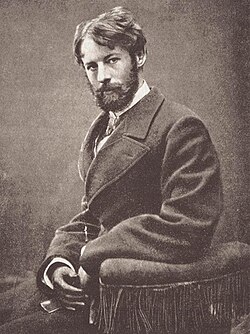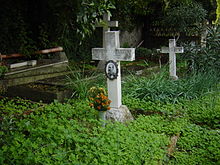Wilhelm von Gloeden
Wilhelm Iwan Friederich August von Gloeden (born September 18, 1856 in Volkshagen , † February 16, 1931 in Taormina ) was a German photographer who mainly worked in Sicily . He is considered one of the pioneers of artistic nude photography . He became famous for his nudes of Sicilian boys with antiquing props and costumes that suggest an Arcadian antiquity. Et in Arcadia ego (“I was in Arcadia too”) was a household word during Gloeden's lifetime and gave its name to an exhibition about his work in the 21st century.
From a modern point of view, his work is meaningful through the controlled use of lighting and the often elegant poses of his models. He was also the first photographer to use body make-up (a mixture of milk, olive oil and glycerine ) to hide the unclean skin of the boys who were always working.
biography
Wilhelm von Gloeden claimed to be the son of an officer and baron from Mecklenburg and gave a "Volkshagen Castle near Wismar " as his place of birth . This information is given in many biographical texts about von Gloeden. However, there are no indications for the title of baron, nor for his father's activity as an officer, nor for the existence of a Volkshagen castle near Wismar.
Von Gloeden came from a Mecklenburg branch of the noble family von Gloeden . His grandfather, Iwan von Glöden († 1825), was an officer and served in Hamburg during the war of liberation against Napoleon. His father, Hermann von Gloeden (1820–1862), was appointed forester in Volkshagen (today Völkshagen , near Marlow, east of Rostock ) in 1851 and in 1856 as forest inspector in Dargun . His mother, Charlotte, b. Maaßen, had previously been married to Johann Magnus Wilhelm Raabe († 1848) for the first time. The law professor Friedrich Maassen and the Parchim mayor August Drechsler were maternal uncles, the lawyer and conservative publicist Iwan von Gloeden was a paternal uncle. On October 10, 1856 Wilhelm von Gloeden was baptized in the church of Blankenhagen .
After the death of his father, his mother married Wilhelm Joachim von Hammerstein in 1864 . Von Gloeden describes the relationship with his stepfather as not good. The most important family reference point for him was his half-sister Sophie Raabe from his mother's first marriage, who accompanied him for years in Sicily.
Von Gloeden studied art history and painting and had a passionate love for the theater. A serious lung disease led him to move to Taormina in Sicily in 1876 because of the climate . Here he made friends with the mayor of Taormina, the German painter Otto Geleng . This and his considerable wealth compared to the extremely poor population of southern Italy at the time may explain why his homosexuality and its obvious manifestation in his work was tolerated by the locals.
Gloeden, for his part, found himself in an Italy that revived a mythical ideal of antiquity: “Reading Homer and Theocrit's poems in Sicily stimulated my imagination. Rocks and sea, mountains and valleys told me about Arcadian shepherds and about Poliphem ” . The relaxed relationship of the population to nudity (back then, children were often seen naked in public) may have been a release for him from German physical hostility and prudery.
In addition to the boys' files, which Gloeden began in 1880, he also made portrait studies of the local farm workers and photographed landscapes. When his family got into financial hardship due to the Hammerstein affair in the 1890s , his hobby turned into a profession. Already a local celebrity in the Taormina area, his work quickly became popular across Europe through various exhibitions (London and Berlin).
His studio was mentioned in the Baedeker , which led to the fact that sizes such as B. Oscar Wilde , the "cannon king" Friedrich Alfred Krupp , Richard Strauss and the German Kaiser Wilhelm II traveled to Taormina. Around the turn of the century, the postcard business began, which made Gloeden even more famous. The majority of Gloeden's work dates from the time up to the beginning of the First World War . During the war he had to leave the country, after his return in 1918 he took very few photos. On his death, Gloeden left his work to his assistant Pancrazio Buciunì (the name appears variously corrupted as Bucinì or Bucini).
The way to photography

At the time of his arrival in Taormina Gloeden was still a hobby photographer and should have acquired his first photographic knowledge from his cousin Guglielmo Plüschow . Plüschow was already an established photographer in Rome and certainly introduced Gloeden to nude photography.
Equipped with this knowledge, fascinated by the landscape, the historical surroundings and the population, Gloeden quickly began to record his impressions photographically. Through this interest he made contact with the local photographer Giovanni Crupi , who was far ahead of Gloeden with his equipment and experience. Gloeden owes much of his phototechnical knowledge to this intensive contact, which is why Crupi is often referred to as the “teacher” of Gloeden. Certainly there was also a series of mutual influences when it came to the choice of motifs. The early photographs by Crupi show, for example, Greek temples in Taormina with almost random-looking local people as attributes. Gloeden took up this topic, but increasingly concentrated on the people and let the historical surroundings disappear into the background as a romantic backdrop.
Through this activity he gained contact with the impoverished local population, at the same time showed himself interested in their poor living situation and tried to help. Gloeden never broke off this interest in the fate of people throughout his life. He later set up accounts for his photo models, to which part of the profit was paid in through postcards and prints.
In today's literature on Gloeden, his early photographic work on the landscape and population of Sicily is drowned out by today's interest in his nude photographs, but it is precisely these early recordings that aroused international interest in his work and Taormina as a tourist destination.
His social interest and the rise of Taormina as a tourist destination strengthened his local position and he won the trust of the population. So it is not surprising that his nude photos of young men, which were later openly distributed, and his homosexual tendencies were accepted by the population at the time.
plant
Gloeden only worked with plate cameras , which required a long exposure time. This means that his photographs had to be carefully staged. This may have contributed to the great, almost archaic calm that his photographs often exude. He was one of the first photographers to take nude photos in the open air, which only became popular around the turn of the century. The collodion process used required that the glass plate had to be processed immediately on site, so Gloeden had a kind of mobile darkroom with him . Gloeden left around 3,000 photographs, the majority of which were destroyed by the fascist police under Mussolini on charges of pornography. Today some of his works can be found in museums in southern Italy, but most of them are likely to have come from private collectors; the archive of the Berlin Society for Anthropology, Ethnology and Prehistory in Berlin has a larger holdings .
effect
In the 1960s Gloeden was rediscovered during the sexual revolution . His photographs were exhibited at documenta 6 in Kassel in 1977 . Artists such as Robert Mapplethorpe , Cecil Beaton , Andy Warhol and Bruce Weber appreciated and collected his photographs. In 1978 the artist Joseph Beuys produced a multiple entitled “von Gloeden-Postkarten” , consisting of 13 pencil-drawn, signed and numbered postcards with motifs from photographs of Gloeden, which was published by the Edizioni Lucio Amelio in Naples.
Much of the post-war gay photography shows Gloeden's influence. To this day, exhibitions of his works lead to irritations and disputes. For example, at the opening of the Gloeden Show in Memmingen in 2008, the Memmingen youth welfare office accused the cultural office of dealing with the subject of “boy love” too carelessly and with an artist doing the same thing “what pedophiles and pederasts do today in Thailand and Cambodia” ( see also sex tourism ). Kunsthalle boss Joseph Kiermeier-Debre called these accusations unjustified and sometimes " infamous ". The show met with great interest nationwide.
A street in Taormina bears his name: Via Wilhelm Von Gloden (sic).
Exhibitions
- Annual exhibitions of the Royal Photographic Society , London 1893 ff.
- International exhibition on amateur photography, Berlin 1899
- Baron Wilhelm von Gloeden (1856–1931). Kunsthalle Basel 1979
- Wilhelm von Gloeden - I was in Arcadia too. MEWO Kunsthalle Memmingen (January 27 - October 26, 2008)
literature
- Wilhelm von Gloeden: Taormina. With a text by Ulrich Pohlmann. Schirmer / Mosel, Munich et al. 1998, ISBN 3-88814-474-4 .
- Bernhard Albers (ed.): Vincenzo Galdi, Wilhelm von Gloeden, Wilhelm von Plüschow. Nude recordings from the Uwe Scheid collection (= library of the gaze. Vol. 3). Rimbaud, Aachen 1993, ISBN 3-89086-938-6 .
- Peter Weiermair : Wilhelm Von Gloeden. Taschen, Cologne 1993, ISBN 3-8228-9386-2 .
- Volkmar Sigusch : Perversion as a work of art. In: Volkmar Sigusch: Neosexualities. About the cultural change of love and perversion. Campus-Verlag, Frankfurt a. a. 2005, ISBN 3-593-37724-1 , p. 123 ff.
- Joseph Kiermeier-Debre , Fritz Franz Vogel (ed.): Wilhelm von Gloeden - I too in Arcadia. The Heinz Peter Barandun Collection, Zurich, Baron Wilhelm von Gloeden, Guglielmo Plüschow, Gaetano d'Agata, Giovanni Crupi, Vincenzo Galdi. Böhlau, Cologne et al. 2007, ISBN 978-3-412-20065-7 .
- Grete Grewolls: Who was who in Mecklenburg and Western Pomerania. The dictionary of persons . Hinstorff Verlag, Rostock 2011, ISBN 978-3-356-01301-6 , p. 3365 .
Web links
- Literature about Wilhelm von Gloeden in the state bibliography MV
- Literature by and about Wilhelm von Gloeden in the catalog of the German National Library
- Biography and gallery
- Biography and gallery
- Wilhelm von Gloeden (1856–1931) .
Footnotes
- ↑ a b c Roger Peyrefitte , Excerpts from the memories of Baron Wilhelm v. Gloeden. In: Eldon Garnet (Ed.): Impulse Archeology. University of Toronto Press, Toronto et al. 2005, ISBN 0-8020-8787-6 , p. 114.
- ^ Government gazette for the Grand Duchy of Mecklenburg-Schwerin. Born 1851, ZDB -ID 704327-2 , p. XXVII .
- ↑ General forest and hunting newspaper. Vol. 33, 1857, ISSN 0002-5852 , p. 185 .
- ↑ Jörg Schellmann (Ed.): Joseph Beuys, the Multiples. Catalog raisonné of the edition objects and prints. 8th edition. Edition Schellmann et al., Munich et al. 1997, ISBN 3-88814-199-0 , p. 226.
- ↑ Hans Kratzer, Roman Deininger: "There's a lot going on in the provinces" . In: Süddeutsche Zeitung , May 17, 2010.
| personal data | |
|---|---|
| SURNAME | Gloeden, Wilhelm von |
| ALTERNATIVE NAMES | Gloeden, Wilhelm Iwan Friederich August von (full name) |
| BRIEF DESCRIPTION | German photographer |
| DATE OF BIRTH | September 18, 1856 |
| PLACE OF BIRTH | Volkshagen |
| DATE OF DEATH | February 16, 1931 |
| Place of death | Taormina |



